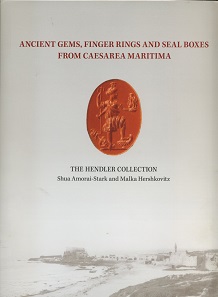by Ursula Kampmann
translated by Christina Schlögl
May 4, 2017 – It is an impressive book, published in Tel Aviv in 2016. It presents the private collection of Johanan Hendler, who gathered the objects between 1950 and the early 1970s. There are an impressive 190 gems and cameos of the late Hellenistic, Roman, Byzantine, Sasanid and Ismalic cultures. In addition, there are 179 uncut jewellery stones, whose shape and material specifically indicate their use. Furthermore the collection contains 110 finger rings and 11 seal boxes. All of these objects have one thing in common: They were all discovered as surface finds in Caesarea Maritima. With its impressive Roman theatre, its palace complexes and commercial streets, this city of Palestine, located at the Mediterranean, is one of the most significant archaeological sites in modern Israel.
Shua Amorai-Stark, Malka Hershkovitz, Ancient Gems, Finger Rings and Seal Boxes from Caesarea Maritima. The Hendler Collection. Self-published by Shay Hendler 2016. 541 p. all illustrations in colour, 31.2 x 23.6 cm. Hardcover. ISBN: 978-965-555-911-8. US$320 including shipping.
This book is the positive result of a request by the Israel Antiquities Authority from 6 August 2009 to report all privately owned archaeological objects to the agency in order to make them accessible to scholars and the public. All collectors who were willing to do this got the legally assured property right to their collection confirmed by documents, as well as the opportunity to publically exhibit their collection. Johanan Hendler’s collection has turned out to be of such importance for research that it has now been presented in a weighty book.
The two scholars Shua Amorai-Stark and Malka Hershkovitz could be won as authors for this comprehensive annotated catalogue. Amorai-Stark is a professor emeritus for art history and art appreciation at Kaye College in Beer-Sheba and has been specialised in glyptics for many years. Malka Hershkovitz is a professor emeritus, too, but she was a professor at the archaeological department of the Hebrew University of Jerusalem and the Hebrew Union College. She was part of the excavations of Masada and Tel Dan and has published a lot on the period of the Second Temple and the Roman period.
Together they have created a basic work which does not only serve as a catalogue to the individual objects of this collection but also discusses fundamental questions on the subject matter. The material is divided into categories – gems, stones, rings, seal boxes and finds from workshops for the production of glyptic objects. All object categories are preceded by their own specific introduction. Every section is completed by an evaluation.
The descriptions and annotations of the individual objects with sublime images constitute the essence of the book. They show us that Caesarea Maritima must have been a manufacturing centre for gems, jewellery stones and rings in Roman and Byzantine times. Indexes, statistics and an extensive bibliography top this impressive book off.
To sum up, it is safe to say that this book is an absolute must for gem-lovers. It is not just another catalogue with pretty pictures of beautiful gems. It is the publication of extraordinary material, which enables us to reconstruct the manufacturing process of these little works of art.
You will find more information on this book on this website.
You can directly order the book via email.




